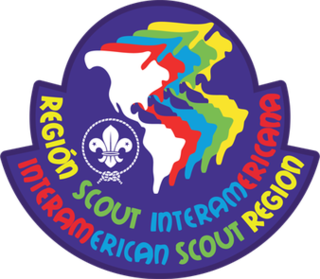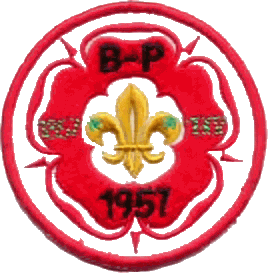Related Research Articles

In Scouting, a jamboree is a large gathering of Scouts who rally at a national or international level.

The Scout Association of Japan is the major Scouting organization of Japan. Starting with boys only, the organization was known as Boy Scouts of Japan from 1922 to 1971, and as Boy Scouts of Nippon from 1971 to 1995, when it became coeducational in all sections, leading to neutral naming. Scouting activity decreased radically during World War II but slowly recovered; membership at the end of May 2017 was 99,779.

The World Scout Emblem is the emblem of the World Organization of the Scout Movement and is worn by Scouts and Scouters around the world to indicate their membership. Each national Scout organization determines the manner in which the emblem is worn.

The Interamerican Region is the divisional office of the World Scout Bureau of the World Organization of the Scout Movement, headquartered in Ciudad del Saber, Panama. The Interamerican Region services Scouting in the Western Hemisphere, both North and South America. Until the 1960s, the "Inter-American Scout Advisory Committee" serviced only Mexico, Central and South America, with Canada and the United States serviced through the then-named "Boy Scouts International Bureau" in Ottawa, Ontario, Canada. Even today, the Interamerican Region exists more for the benefit of countries south of the Rio Grande, as evidenced by the website being only in Spanish until 2011; consequently, the United States and Canada did not participate as vigorously in regional activities as do other national organizations around the world, however this is changing in the 2010s.
The Danish Scout Council is the national Scouting federation of Denmark. Scouting was founded in Denmark in 1909 and among the charter members of WOSM in 1920. Denmark has 70,000 Scouts.
The Scout and Guide movement in Denmark consists of about ten different associations. Most of them are members of two large federations, but there are also some independent organizations. Affiliated to Danish Scouting and Guiding are the organizations in Greenland, on the Faroe Islands and in Southern Schleswig.

The 1st World Scout Jamboree was held from 30 July 1920 to 8 August 1920 and was hosted by the United Kingdom at Kensington Olympia in London. 8,000 Scouts from 34 nations attended the event, which was hosted in a glass-roofed building covering an area of 6 acres (24,000 m2).

Cay Lembcke was a co-founder of the Danish Boy Scouts Organization in 1910 and the National Socialist Workers' Party of Denmark in 1930. He was captain of the Danish Guard Hussars until his resignation in 1923, following public disagreement with the Danish government over budget cuts in the Danish defence.

The 9th World Scout Jamboree, also known as the Jubilee Jamboree, was held at Sutton Park, Royal Town of Sutton Coldfield, Warwickshire, England, for twelve days during August, 1957. The Jamboree marked dual milestones as it was both the 50th anniversary of the Scouting movement since its inception at Brownsea Island and the 100th anniversary of the birth of Scouting's founder Robert Baden-Powell.

Hidesaburō Kurushima was President, then International Commissioner, and Chairman of the National Board of the Boy Scouts of Japan, the younger brother of Nakano Chūhachi. An engineer, he had a successful career in mining, shipping and chemicals. He was also an accomplished author, published several books on Indochina, and short stories in addition to scientific publications related to his work.

The 7th World Scout Jamboree was held August 3 to 12, 1951 and was hosted by Austria at Bad Ischl in Upper Austria. The attendance was 12,884 from 61 different parts of the world, with 675 German Scouts given a warm welcome as official participants in a World Jamboree for the first time. The Austrian contingent was slightly outnumbered by the Commonwealth contingent, and had reduced the minimum age for their attendees from 14, the normal Jamboree age, to 13, since the revived organization had only been in existence for five years. The 7th World Scout Jamboree was also the last Jamboree for which Austria were the host country.

The 2nd World Scout Jamboree was held from August 9 to 17, 1924 and was hosted by Denmark at Ermelunden.

The Yellow Scouts of Denmark — Baden-Powell Scouts were founded on 25 February 1984 as "Det Danske Pige- og Drenge Spejderkorps" with the aim of returning to a more traditional Scouting approach as a response to changes in the mainstream Danish Scouting movement.
Christian Holm served as President of Det Danske Spejderkorps, and host of the 2nd World Scout Jamboree, held from August 9 to 17, 1924 at Ermelunden, Denmark.

Ove Holm served as Organizing Secretary and Administrator of the 2nd World Scout Jamboree, held from August 9 to 17, 1924 at Ermelunden, Denmark, and Chief Scout of Det Danske Spejderkorps from 1924 to 1960. He graduated from w:da:Gammel Hellerup Gymnasium in 1912 and was awarded the Bronze Wolf, the only distinction of the World Organization of the Scout Movement, awarded by the World Scout Committee for exceptional services to world Scouting, in 1949.
Jens Hvass served as the Camp Chief of the 2nd World Scout Jamboree, held from August 9 to 17, 1924 at Ermelunden, Denmark, and was later a state forester and Divisional Scout Commissioner in Rold Skov, North Jutland, where a jamboree-square can still be found near the Great Økssø.
Rear-Admiral Carl Vilhelm Edvard Carstensen, (1863–1940) acting as the personal representative of King Christian X of Denmark, officially opened the 2nd World Scout Jamboree on 10 August 1924, held from 9 to 17 August 1924 at Ermelunden, Denmark.
Hans Hartvig Møller was the Rector (1909-1943) of Gammel Hellerup Gymnasium (GHG) founded in 1894 and originally a private school exclusively for boys, the founder of student council in Denmark, and one of the founders of Danish Scouting.
Fritz M. de Molnár was a Scouting pioneer in Hungary. He became the Hungarian International Scout Commissioner.
Ungdomsøen is a youth camp located on the artificial island of Middelgrundsfortet in the Øresund sound between Copenhagen and Malmö.